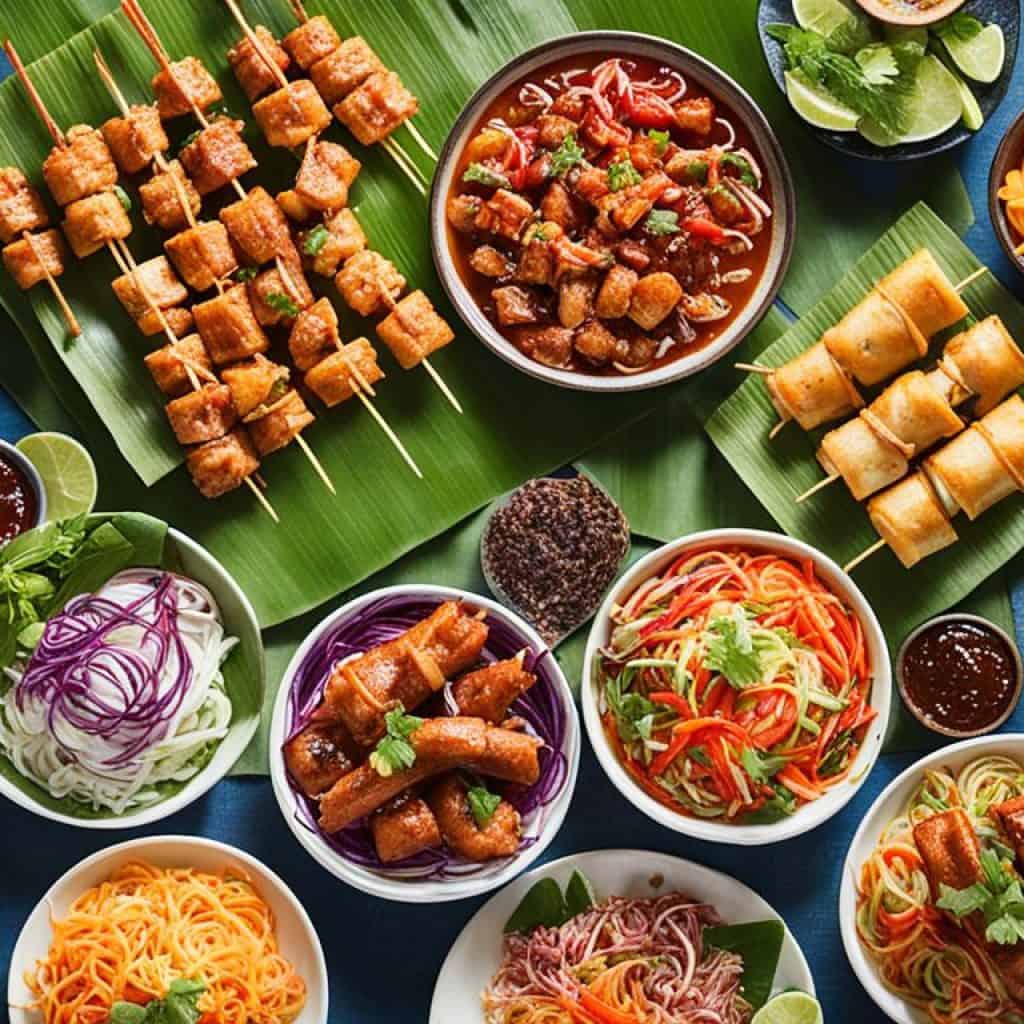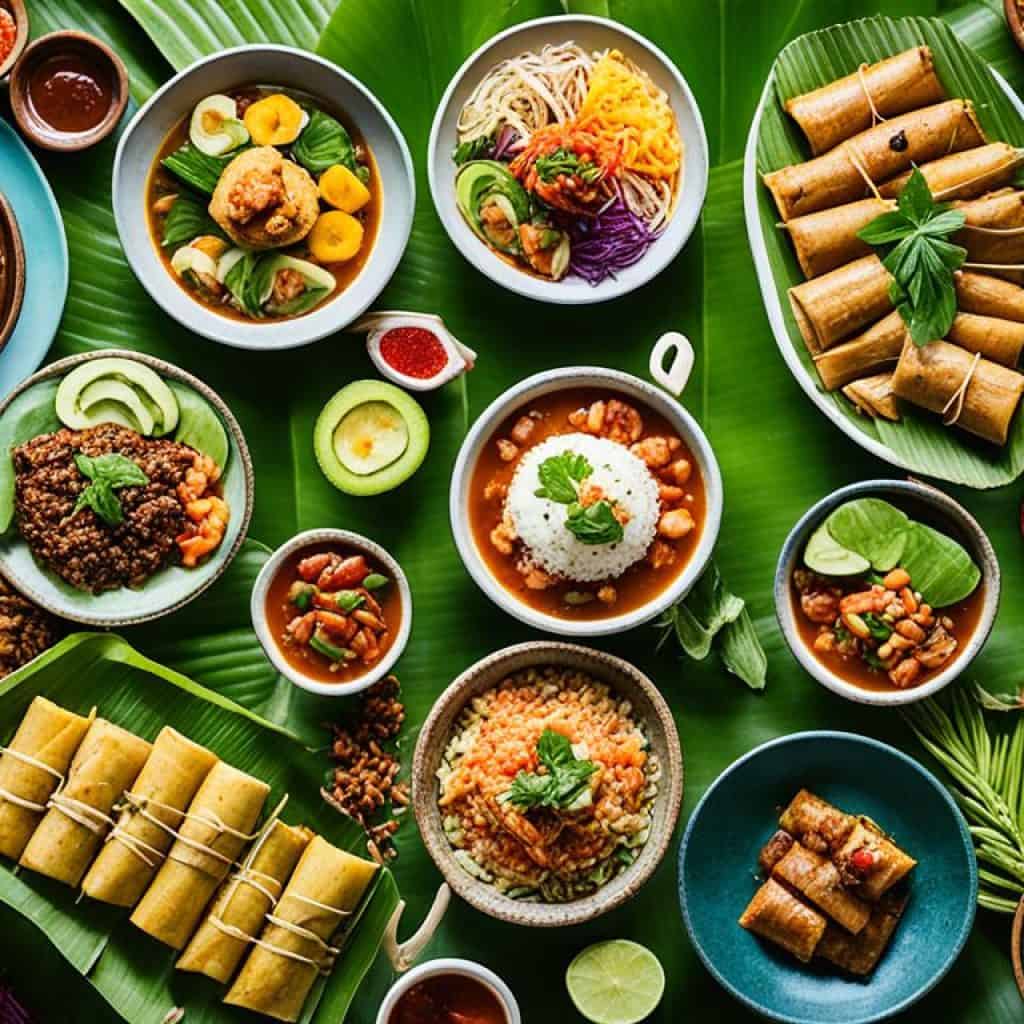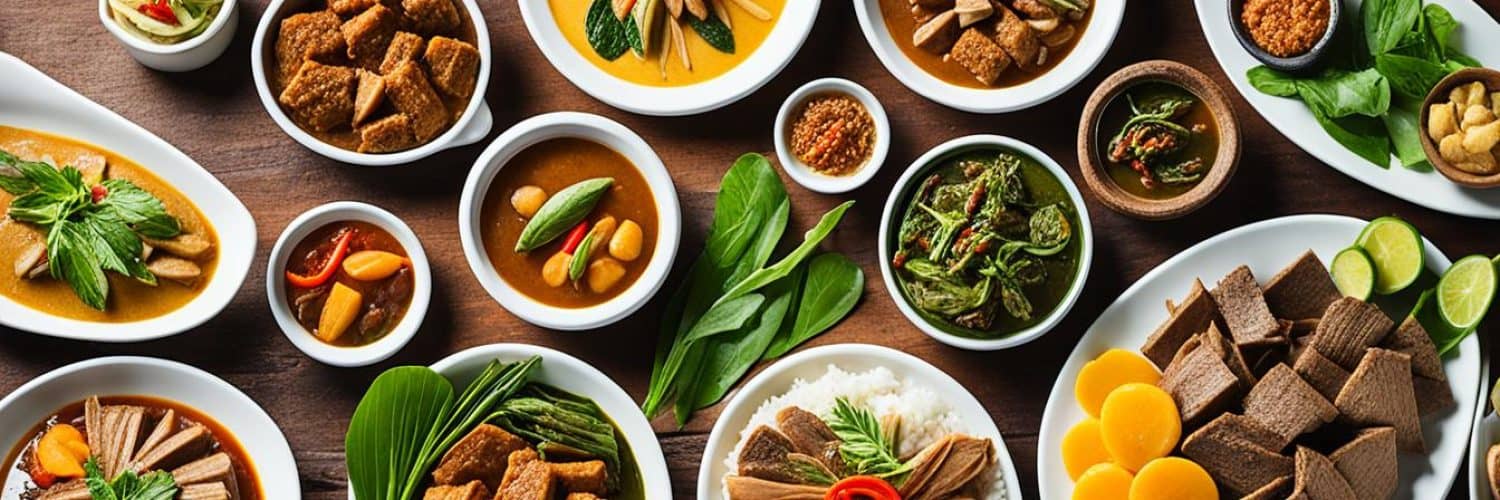Are you ready to start a journey through the exciting world of Filipino cuisine? Immerse yourself in the tastes of dishes like savory adobo and sweet halo-halo. Filipino food is packed with special flavors and recipes that will amaze your senses.
Enter the kitchen to uncover the secrets of famous Filipino foods such as sinigang, pancit, and lechon. Discover the unique ingredients like tangy calamansi and savory bagoong that define Filipino dishes. This article is perfect for food lovers or anyone curious about Filipino flavors. It promises an unforgettable journey.
Key Takeaways:
- Filipino cuisine boasts lively flavors and a blend of sweet, savory, and tangy tastes.
- There’s a wide variety of traditional Filipino recipes, fit for daily meals or big celebrations.
- The Philippines offers numerous fresh and tasty ingredients, crucial for Filipino dishes.
- Street food in the Philippines is a key part of the culture, offering exciting tastes for those who love to try new things.
- Don’t miss out on Filipino desserts. They come in many flavors and textures, perfect for those with a sweet tooth.
Filipino Recipes for Every Occasion
Explore the rich tastes of Filipino cuisine for any event. Whether it’s a big dinner, a family meal, or a craving for Filipino taste, you’ll find traditional dishes to love.
Adobo is famous worldwide. It’s a mix of soy sauce, vinegar, garlic, and spices. You can make it with chicken, pork, or seafood. This dish’s unique sour and rich taste is loved by many.
For a delicious noodle dish, try pancit. It’s stir-fried noodles with veggies, meat or seafood, seasoned with soy sauce and citrus. Pancit has different types like canton or palabok, each with a unique flavor.
“Explore the variety of Filipino cuisine for any event. From the savory adobo to the tasty pancit, discover the flavors and special ingredients that make Filipino food beloved.”
Don’t miss sinigang for a warm meal. This tangy soup has a tamarind base. It’s filled with veggies and meats like pork, beef, or shrimp. Sinigang’s sour taste will make you want more.
Indulge in the sizzling goodness of sisig
Crave bold, flavorful food with sisig. From Pampanga, the Philippines’ culinary capital, sisig is made from pig’s face and ears. Seasoned with calamansi, chilies, and spices, it’s served sizzling. People often enjoy it with rice or beer.
Experience the mouthwatering taste of kare-kare
Try kare-kare for a unique flavor. This stew has oxtail, tripe, or beef, in peanut sauce with vegetables. Its complex taste and creamy sauce make it great for special times.
Filipino cuisine has something for all. From heirloom dishes to new twists on classic tastes, Filipino recipes offer a memorable culinary adventure.
Popular Filipino Ingredients
Filipino food is all about vibrant tastes and unique items. These traditional spices and local elements define Filipino meals. Let’s dive into the popular Filipino ingredients that enrich recipes.
Calamansi
Calamansi looks like a small orange or lime. It’s a citrus fruit from the Philippines with a tangy flavor. It’s often used to bring a citrusy zest to Filipino food.
Bagoong
Bagoong is a fermented seafood paste, made from shrimp or fish. This paste is a flavor booster in Filipino cooking. It brings umami taste to dishes like Kare-Kare and Sinigang, making them richer.
Lemongrass
Lemongrass is cherished in Filipino cuisine for its citrusy flavor. It’s used in soups, stews, and marinades for its aroma. This herb adds a fragrant touch to Filipino dishes.
Saba Bananas
Saba bananas are known as cooking bananas. They are sweeter and firmer than ordinary bananas. These bananas are key in Filipino desserts like turon and halo-halo, providing sweetness and texture.
“The use of these Filipino ingredients contributes to the rich and aromatic flavors that make Filipino cuisine so beloved.”
Filipino ingredients offer diversity and amazing flavors. Adding these spices and items to your cooking takes you to the essence of Filipino food. You get to enjoy the genuine taste of this colorful food culture.
Exploring Filipino Street Food
Filipino street food is full of life and color. Walk through street markets, and you’ll smell delicious foods cooking. The Philippines is known for its amazing street foods. They show off the country’s tasty flavors and rich food traditions.
Have you ever walked the streets of Manila? Or maybe you want to try making Filipino snacks at home. Either way, you can explore this amazing street food culture. And the best part? You don’t need to go far to enjoy these yummy treats!
Fish balls are a favorite among Filipino street foods. They’re made from ground fish and flour. Then, they’re served with a sweet and tangy sauce. Paired with a cold drink, they’re a must-try!
For those who like to try new things, balut is interesting. It’s a boiled duck egg with a small embryo inside. It sounds different, but balut is a real cultural experience. It’s something adventurous eaters should try.
Looking for something tasty and satisfying? Filipino street food has lots of options. There’s “ihaw-ihaw,” meat skewers, and “lechon kawali,” crispy pork belly. These come with spicy vinegar or a chili-garlic dip. They add zing to every bite.
The Allure of Homemade Filipino Snacks
What’s special about homemade Filipino snacks? It’s the love and care put into them. These recipes are treasures passed down through families. They share the Filipino food culture. Making these at home lets you enjoy these flavors and connect with this rich heritage.
Making Filipino street food at home is fun. You can add your own twist to the recipes. Try different seasonings and sauces. Whether for a party or a snack, homemade Filipino food will impress everyone.
Dive into Filipino street food for its bold flavors and colors. From fish balls to balut, there’s much to try. The spices, colors, and variety make it irresistible. Filipino street food is something you’ll want more of.
Let’s continue our food journey. Next, we’ll explore Filipino desserts and sweet treats. Stay tuned!
Filipino Desserts and Sweet Treats
Explore the delightful world of Filipino desserts. They offer a wide range of sweet treats from old favorites to new innovations. You’re sure to find something to fulfill any sweet craving.
Popular Filipino Sweets
- Bibingka – A soft and fluffy rice cake topped with salted egg, cheese, and grated coconut, often enjoyed during Christmas festivities.
- Puto – Bite-sized steamed rice cakes that come in various flavors and colors, perfect for snacking or as a complement to savory dishes.
- Turron – A crunchy, deep-fried snack made with banana and wrapped in spring roll wrappers, sprinkled with sugar for an extra touch of sweetness.
“Filipino desserts are a delightful combination of flavors and textures. They showcase the use of local ingredients like coconut, jackfruit, and sweet rice, resulting in unique and unforgettable treats.” – Chef Maria Santos
Try the halo-halo, meaning “mix-mix”. It’s a vibrant dessert with crushed ice, sweet beans, fruits, jellies, and leche flan. The ube ice cream and evaporated milk topping make it extra special. It’s perfect for cooling down on a hot day.
If you enjoy creamy desserts, don’t miss the leche flan. This smooth custard made with egg yolks, condensed milk, and caramelized sugar is a classic. It’s often found at celebrations, beloved for generations.
A Table of Filipino Desserts
| Dessert | Description |
|---|---|
| Buko Pandan | A refreshing dessert made with young coconut, pandan jelly, and tapioca pearls, mixed with a creamy blend of condensed milk and pandan-flavored gelatin. |
| Turon | This sweet banana spring roll is a popular street food snack, typically made with ripe bananas wrapped in spring roll wrappers, deep-fried, and coated with caramelized sugar. |
| Maja Blanca | A creamy coconut pudding made with coconut milk, cornstarch, and sweet corn kernels. It is often topped with toasted grated coconut for added texture and flavor. |
Filipino desserts are more than sweet treats. They represent Filipino culture and traditions. Every bite carries the warmth and hospitality, leading to joyful and celebratory moments.
Whether you want something sweet and creamy or a cool icy treat, there’s a whole world of flavors to discover in Filipino desserts.
Exploring Filipino Party Food
Filipino parties are full of abundant and tasty food during celebrations. These include birthdays, weddings, and reunions. To add Filipino flavor to your party, here are some dishes and recipes.
Traditional Filipino Party Dishes
These dishes show the Philippines’ rich food history. They come from recipes shared over generations. They are loved globally.
- Lechon: A whole roasted pig, crispy on the outside and tender on the inside. Lechon is often the centerpiece of Filipino celebrations.
- Kare-Kare: A savory stew made with oxtail, tripe, and vegetables, cooked in a rich peanut sauce. It’s often served with bagoong, a fermented shrimp paste.
- Pansit: A noodle dish that symbolizes long life and good fortune. Pansit can be made with various types of noodles and topped with meat, seafood, and vegetables.
These Filipino dishes are tasty and showcase the country’s unique cuisine. Adding them to your menu will impress guests with authentic flavors.
Festive Filipino Recipes
For a twist on traditional dishes, try these Filipino recipes. They mix familiar tastes with new ideas. Here’s what you can make:
- Sisig Sliders: Turn the classic sisig into small sliders. They’re served on mini buns with a tangy sauce. It’s a delicious snack.
- Mango Avocado Salad: This salad brings together mangoes and avocados. It’s mixed with greens and a zesty dressing. The salad adds a tropical vibe.
- Ube Cheesecake: This dessert uses ube, a purple yam. It gives the cheesecake a unique color and taste, making it irresistible.
These recipes add a new and bold taste to your party. They are creative takes on traditional Filipino dishes.
“Filipino parties are not just about the delicious food, but the joy and warmth we share with our loved ones. It’s a celebration of our culture, heritage, and togetherness.”
A Taste of the Philippines at Your Party
Bring Filipino party food’s lively flavors to your celebration. You can stick with traditional dishes or try new recipes. Either way, your guests will enjoy the flavors and Filipino hospitality.
So, get everyone together, prepare the feast, and make your party memorable with Filipino tastes. Mabuhay at magsaya!

| Traditional Filipino Party Dishes | Ingredients | Description |
|---|---|---|
| Lechon | Whole pig, lemongrass, garlic, salt, pepper | A succulent whole roasted pig with crispy skin, often marinated in a flavorful mixture of lemongrass, garlic, salt, and pepper. It’s the star of the show at Filipino celebrations. |
| Kare-Kare | Oxtail, tripe, eggplant, string beans, peanut butter, annatto seeds | A hearty stew made with oxtail, tripe, and vegetables, cooked in a thick and creamy peanut sauce. The dish is often enhanced with the distinct red-orange color of annatto seeds. |
| Pansit | Noodles (varies), meat or seafood, vegetables, soy sauce, calamansi juice | A versatile noodle dish made with different types of noodles, stir-fried with meat, seafood, and vegetables. It’s typically seasoned with soy sauce and calamansi juice for a tangy and savory flavor. |
Authentic Filipino Cookbooks and Bloggers
Explore Filipino cooking with the best cookbooks and blogs. Check out Casa Veneracion to Panlasang Pinoy for tools to make authentic Filipino dishes.
Top Filipino Cookbooks
- Memories of Philippine Kitchens by Amy Besa and Romy Dorotan: Dive into the Philippines’ rich food history and traditional recipes with this illustrated cookbook.
- The Filipino Cookbook by Miki Garcia: This cookbook, with over 85 authentic recipes, introduces you to Filipino flavors and techniques.
- 7000 Islands: A Food Portrait of the Philippines by Yasmin Newman: Take a culinary journey across the Philippines. The book highlights the diverse regional specialties and traditional dishes.
Popular Filipino Food Bloggers
- Casa Veneracion: Connie Veneracion’s blog offers many Filipino recipes and cooking tips.
- Panlasang Pinoy: Vanjo Merano’s blog gives detailed videos and steps for making Filipino dishes at home.
- The Burnt Lumpia: Marvin Gapultos blends tradition with unique twists in his Filipino food recipes.
“Filipino cuisine reflects the country’s rich history and diverse cultures. These cookbooks and blogs give you authentic recipes and insights into the stories behind the dishes. They are great for anyone wanting to explore Filipino cooking.”
Authentic Filipino Recipes
With these cookbooks and blogs, you can make traditional Filipino recipes yourself. Try making classic adobo or tasty sinigang. You’ll get step-by-step instructions and expert tips for authentic taste.
Check out the beautiful food photos, personal stories, and cultural insights. These resources are more than recipes. They show the heart and soul of Filipino cuisine.
Expand Your Culinary Horizons
By looking into Filipino cookbooks and blogs, you learn new recipes and about Filipino culture and heritage. Dive into the flavors, traditions, and stories of each dish. Start your delicious culinary journey.
Filipino Ingredients Guide
Let’s start a culinary adventure and explore the essentials of Filipino cuisine. Discover spices and unique tastes that are key for Filipino dishes. Elevating your Filipino cooking starts with these vital elements.
Popular Filipino Spices
Spices are vital in Filipino dishes as they enrich and deepen flavors. Let’s look at some standout spices:
- Garlic: It’s known for its strong smell and taste, essential in many Filipino meals like adobo.
- Onion: Onions are basic yet vital, giving sweetness and bite to dishes including bistek tagalog.
- Ginger: Ginger offers a warm, zesty taste. It’s great in savory and sweet recipes, adding spice to tinola.
- Chili Pepper: For a spicy kick, chili pepper is key. It varies from very hot to mild, perfect in Bicol express.
Essential Filipino Ingredients
Filipino cuisine also features unique ingredients for its special flavor. Here are essential items for your pantry:
- Calamansi: This sour fruit adds zest to dishes and drinks, refreshing and tangy.
- Bagoong: Fermented shrimp or fish paste enriches dishes with savory, umami flavors. It’s crucial in dishes like pinakbet.
- Lemongrass: With its citrusy aroma, lemongrass flavors soups and curries beautifully. It’s essential in recipes like sinigang.
- Saba Bananas: These bananas are perfect in Filipino desserts, adding sweetness naturally.
This Filipino ingredients guide is your first step in Filipino culinary mastery. With these spices and essential items, you can make dishes full of Philippines’ vibrant flavors.
Filipino Food Culture and Traditions
Filipino cuisine goes beyond tasty food. It’s rooted in culture and traditions. Every traditional Filipino meal holds great meaning. They represent the nation’s history, values, and customs. Let’s dive into the rich culinary heritage behind the vibrant Filipino food culture.
The Role of Food in Filipino Culture
In Filipino culture, food is more than just nourishment. It brings families and communities together. It’s a way to share stories and celebrate life’s milestones. Traditional meals are made with love and generosity. This reflects the Filipino values of hospitality and unity.
Food shows love and care in Filipino society. It feeds both body and soul. It draws people closer, making bonds stronger. This creates unforgettable memories that stay with us forever.
Traditional Filipino Meals
Traditional Filipino meals mix flavors, textures, and colors beautifully. They are often shared family-style. You’ll find a mix of meat, seafood, vegetables, and rice. The “kamayan” meal is special, served on banana leaves for eating by hand. It symbolizes unity and friendship.
The Filipino breakfast, or “silog,” is a tradition. It includes protein, like marinated and grilled meat, with garlic fried rice and a fried egg. It’s a hearty start to any day, setting the tone for productivity.
Customs and Celebrations
Filipino customs and celebrations are incomplete without a big feast. Food is central during birthdays, weddings, fiestas, and holidays. It symbolizes abundance and joy.
The “lechon,” or whole roasted pig, is a celebration staple. Its preparation and presentation are deeply traditional. It highlights Filipino culinary skills during special events.
The Influence of History and Migration
Centuries of history and migration have shaped Filipino food. The Philippines’ location and its colonial history have mixed many flavors and techniques. This blend has created a unique and diverse culinary scene. It keeps evolving but stays true to its roots.
The mix of Filipino ingredients and foreign influences has made a unique culinary landscape. It’s always changing, yet respects its origins.
Image related to Filipino Food Culture and Traditions:
Filipino Fusion Cuisine
Filipino cuisine is celebrated for its traditional flavors. Yet, it has conquered the fusion cuisine scene as well. These dishes mix Filipino tastes with global culinary arts, creating amazing new flavors.
Modern Filipino recipes have evolved. They now include elements from worldwide cuisines. These creations showcase the resourcefulness and ingenuity of Filipino chefs.
Exploring Filipino Fusion Cooking
The adobo pizza is a famous Filipino fusion dish. It blends the savory taste of Filipino adobo with the classic Italian pizza. This mix of tender adobo meat, cheese, and fresh veggies offers a distinct pizza delight.
Sisig taco is another intriguing mix. It combines crunchy Filipino sisig with the soft Mexican taco. The fusion of crispy pork, tortilla shell, and zesty salsa brings an exciting flavor burst.
“Filipino fusion cuisine is a testament to the rich culinary heritage of the Philippines and its ability to adapt and embrace global influences while maintaining its distinct character.”
Sweet treats are also part of Filipino fusion. Take the ube cheesecake, for instance. It merges the Filipino purple yam with creamy cheesecake. This union creates a dessert that’s uniquely Filipino and irresistibly sweet.
Fusion Cuisine at Its Finest: A Taste of Diversity
Filipino fusion dishes showcase the variety and creativity of Filipino cooking. They blend traditional Filipino elements with global ones. This creates exciting and delectable dishes.
This fusion attracts fans of Filipino food and those new to it. It encourages culinary exploration and mixing different food traditions. Are you ready to explore and enjoy the unique tastes of Filipino fusion cuisine? Look for Filipino restaurants that offer modern dishes. You’re in for a treat!
Popular Filipino Fusion Dishes
| 1 | Adobo Pizza |
|---|---|
| 2 | Sisig Taco |
| 3 | Ube Cheesecake |
| 4 | Kare-Kare Burrito |
| 5 | Sinigang Fried Rice |
Filipino Food for Beginners
If you’re new to Filipino cuisine, don’t worry. Start with easy recipes to learn the flavors and techniques of Filipino cooking. These simple ingredients and clear cooking methods are perfect for beginners eager to discover the rich world of Filipino food.
Easy Filipino Recipes
Here are some popular Filipino recipes that are both tasty and easy for beginners:
- Adobo: A classic dish with tender meat or seafood in a savory sauce made of vinegar, soy sauce, and spices.
- Sinigang: A comfy tangy soup with vegetables and your choice protein.
- Pancit: A noodle dish with vibrant flavors and colorful vegetables, great for a quick meal.
- Lumpia: Filipino spring rolls with seasoned ground meat and vegetables, served with a sweet and tangy sauce.
These recipes are easy to follow and can be tailored to your taste. Explore Filipino cuisine with these simple recipes and enjoy the diverse flavors.
“Filipino cuisine is full of flavors and textures. Feel free to experiment and make these dishes your own.”
Simple Filipino Dishes
Try these simple Filipino dishes for an easier kitchen experience:
- Tortang Talong: Grilled eggplant dipped in beaten egg, then fried. It’s simple but flavorful.
- Chicken Adobo Fried Rice: Use leftover adobo to make a tasty fried rice with garlic, onions, and day-old rice.
- Ginataang Kalabasa: A cozy dish with squash and coconut milk, flavored with ginger and chili.
- Pan de Sal: Soft, fluffy Filipino bread rolls, perfect for breakfast or a snack.
These dishes are straightforward and use minimal ingredients. They are fantastic for beginners eager to enjoy Filipino cooking’s simplicity and tastiness.
| Benefits of Starting with Easy Filipino Recipes | Why Choose Simple Filipino Dishes? |
|---|---|
| 1. Become more confident in the kitchen | 1. Save time with quick cooking |
| 2. Learn about Filipino flavors | 2. Find ingredients easily |
| 3. Pick up basic cooking skills | 3. Great for various diets |
| Begin with simple Filipino recipes to build a strong cooking foundation. You can explore more complex dishes later. | |

Whether you’re just starting or already love cooking, Filipino food has something for everyone. Begin with these simple and tasty recipes. Soon, you’ll make delicious Filipino dishes to enjoy and share with others.
Filipino Vegetarian and Vegan Recipes
Filipino cuisine is known for its meat dishes but also has great vegetarian and vegan options. These plant-based dishes are packed with exciting flavors and ingredients, perfect for vegetarians and vegans. You can enjoy the rich flavors of the Philippines in a kind and sustainable way.
Exploring Filipino Vegetarian Recipes
Traditional Filipino vegetarian recipes use a mix of vegetables, grains, legumes, and fruits. These dishes are full of vibrant flavors. For example, adobo tofu offers a vegetarian take on the classic adobo. It uses tofu, soy sauce, vinegar, garlic, and spices. Sinigang sa Miso is a sour soup with vegetables like kangkong and eggplant in a miso broth.
Veganizing Filipino Dishes
You can make vegan versions of many Filipino dishes. Use mushrooms or jackfruit instead of pork to veganize dishes like Kare-Kare. To replace bagoong and patis, use soy sauce or liquid aminos. This way, you can enjoy Filipino flavors and still stick to a vegan diet.
Plant-Based Filipino Cuisine
Plant-based Filipino dishes showcase local and seasonal produce from the Philippines. Besides ingredient swaps, these dishes use coconut milk, banana blossoms, and more. For instance, kamote tops add a nutritious touch to sinigang or adobo. This approach brings out a harmony of flavors and textures in your cooking.
| Vegan Filipino Recipes | Description |
|---|---|
| Mushroom Adobo | A vegan twist on traditional adobo, featuring marinated mushrooms in a tangy soy sauce and vinegar sauce. |
| Ginataang Kalabasa at Sitaw | A creamy coconut milk-based stew with squash and long beans, seasoned with spices and aromatics. |
| Tofu Sisig | A vegan version of the popular sisig dish, made with crispy tofu, onions, and peppers, flavored with soy sauce and calamansi. |
| Vegan Pancit Bihon | A plant-based version of the classic pancit bihon, featuring rice noodles, vegetables, and vegan protein sources like tofu or tempeh. |
Whether you’re vegetarian, vegan, or just interested in plant-based foods, Filipino cuisine has many flavorful dishes to try. Explore the delicious and colorful world of Filipino vegetarian and vegan recipes.
Filipino Food FAQs
Wondering about Filipino cooking? We have all the answers and tips you need on this topic. If Filipino food is new to you or if you’re aiming to improve your cooking skills, keep reading. Your curiosity about Filipino food will be satisfied here.
What are some common questions about Filipino cuisine?
- What is the staple food in Filipino cuisine? The main staple of Filipino meals is rice. It is served with almost every dish, often alongside meats, veggies, and different sauces.
- What are some popular dishes in Filipino cuisine? Well-loved Filipino dishes include adobo, sinigang, and pancit. Adobo is a tasty meat dish soaked in vinegar, soy sauce, and spices. Sinigang is a tangy soup made with meat or seafood and veggies. Pancit is stir-fried noodles with a variety of toppings.
- Is Filipino cuisine spicy? Generally, Filipino food isn’t spicy. But, some local dishes and condiments might be spicy, like Bicol express and some chili sauces.
What are some cooking tips for Filipino cuisine?
- Use Filipino ingredients for authentic flavors. Unique ingredients give Filipino dishes their special taste. Seek out calamansi, bagoong, and coconut vinegar to bring true Filipino flavors to your meals.
- Experiment with flavor combinations. Filipino cooking blends sweet, sour, and savory tastes beautifully. Feel free to try out various flavor mixes to create your own Filipino-inspired dishes.
- Slow cooking for tender meats. Dishes like adobo and kare-kare are perfect for slow cooking. This method makes the meat tender and enriches the dish’s flavor.
“Filipino cuisine is a delightful fusion of flavors and culinary techniques, influenced by various cultures and traditions.”
With these answers and cooking tips in hand, you’re ready to dive into the world of Filipino cuisine. Prepare to excite your taste buds with the vibrant tastes and rich traditions of the Philippines!
Traditional Filipino Drinks
Explore the refreshing flavors of traditional Filipino drinks. From fruity mixes to classic favorites, these beverages offer a unique and delightful experience.
Buko Juice
Buko juice is a favorite in the Philippines. It’s a refreshing drink made from young coconut water. Served in the coconut shell, it has a sweet and nutty taste. It’s perfect for cooling off on a hot day.
Fruit Shakes
Fruit shakes are another popular drink. They’re made from fresh fruits like mango, banana, and pineapple, blended with ice. Their vibrant colors and sweetness make them a year-round favorite.
Sago’t Gulaman
Sago’t Gulaman is a traditional Filipino beverage. It mixes tapioca pearls (sago) and agar jelly (gulaman) in a sweet syrup. This drink is refreshing, satisfying, and has a unique texture. It’s often served at summer events and special occasions.
Calamansi Juice
Calamansi juice is made from a small citrus fruit native to the Philippines. It’s zesty, tangy, and full of vitamin C. This drink is great for health and quenching thirst. You can enjoy it as is or sweeten it with honey or sugar.
Salabat
Salabat, or ginger tea, is a comforting Filipino drink. It’s made by boiling ginger with water and adding calamansi and honey or sugar. This warm drink is perfect for cold months or soothing colds and coughs.
There are many delicious Filipino drinks to try. Whether you crave a refreshing fruit shake or a unique traditional drink, there’s something exciting for your taste buds in the Philippines.
Filipino Food and the Filipino Community
Filipino cuisine celebrates the vibrant community and its rich heritage. It brings people together with meals and traditions. Food is at the heart of Filipino culture.
The warm hospitality of the Filipino community shines through their food. Their culinary knowledge spans generations. It shows the influences of Spanish, Chinese, Malay, and American cuisines.
“Bayanihan” means community spirit in Filipino culture. This spirit is seen in fiestas where everyone enjoys food together. It helps build unity and celebrates cultural identity.
Filipino food is known for its bold flavors and vibrant colors. Dishes like adobo and sinigang are savory. Sweet treats include leche flan and halo-halo. These foods offer a mix of tastes and textures.
The Role of Filipino Food in the Community
Filipino food connects Filipinos around the world to their roots. It reminds them of home and preserves their identity. It also helps pass down traditions.
In Filipino homes, recipes are passed down by “lolas” or grandmothers. These recipes link families to their heritage. They are vital for preserving culture.
Food is important at social events and celebrations within the community. Sharing meals strengthens relationships and fosters belonging. It marks important life events.
“Food is the universal language that connects Filipinos wherever they may be in the world.”
Filipino eateries outside the Philippines are run by passionate individuals. These places let people enjoy authentic Filipino food. They also serve as spots for Filipinos to connect.
The Evolution of Filipino Food Culture
Filipino food culture is evolving while keeping its unique identity. Modern chefs are mixing traditional flavors with new techniques. This leads to exciting dishes that highlight Filipino ingredients.
Social media and cooking shows have introduced Filipino cuisine to the world. This has brought recognition to Filipino food globally. It allows Filipino cuisine to be celebrated alongside other world culinary traditions.
As Filipino communities grow globally, their food remains a vital cultural link. It is a source of pride and celebration. Filipino food invites the world to explore the Philippines’ unique flavors and traditions.
| Key Points |
|---|
| The Filipino community |
| Filipino food culture |
| Filipino culinary heritage |
Conclusion
Start a journey into the world of Filipino food. It mixes age-old recipes with modern ingredients. This mix creates a unique food experience. Whether cooking is new to you or you’re skilled, there’s something in Filipino cuisine for you.
Explore Filipino cuisine’s deep, varied tastes. Enjoy adobo’s mix of soy sauce and vinegar. Or the sweet, icy halo-halo with fruits and jelly. Each meal reflects the Philippines’ mixed culture.
Ready your ingredients and get set for a Filipino food journey. Embrace the food culture with other fans of Filipino cuisine. Dive deep into Filipino food. Play with traditional recipes, blend in new styles, or invent your own dishes. The flavors will amaze you.







Add comment